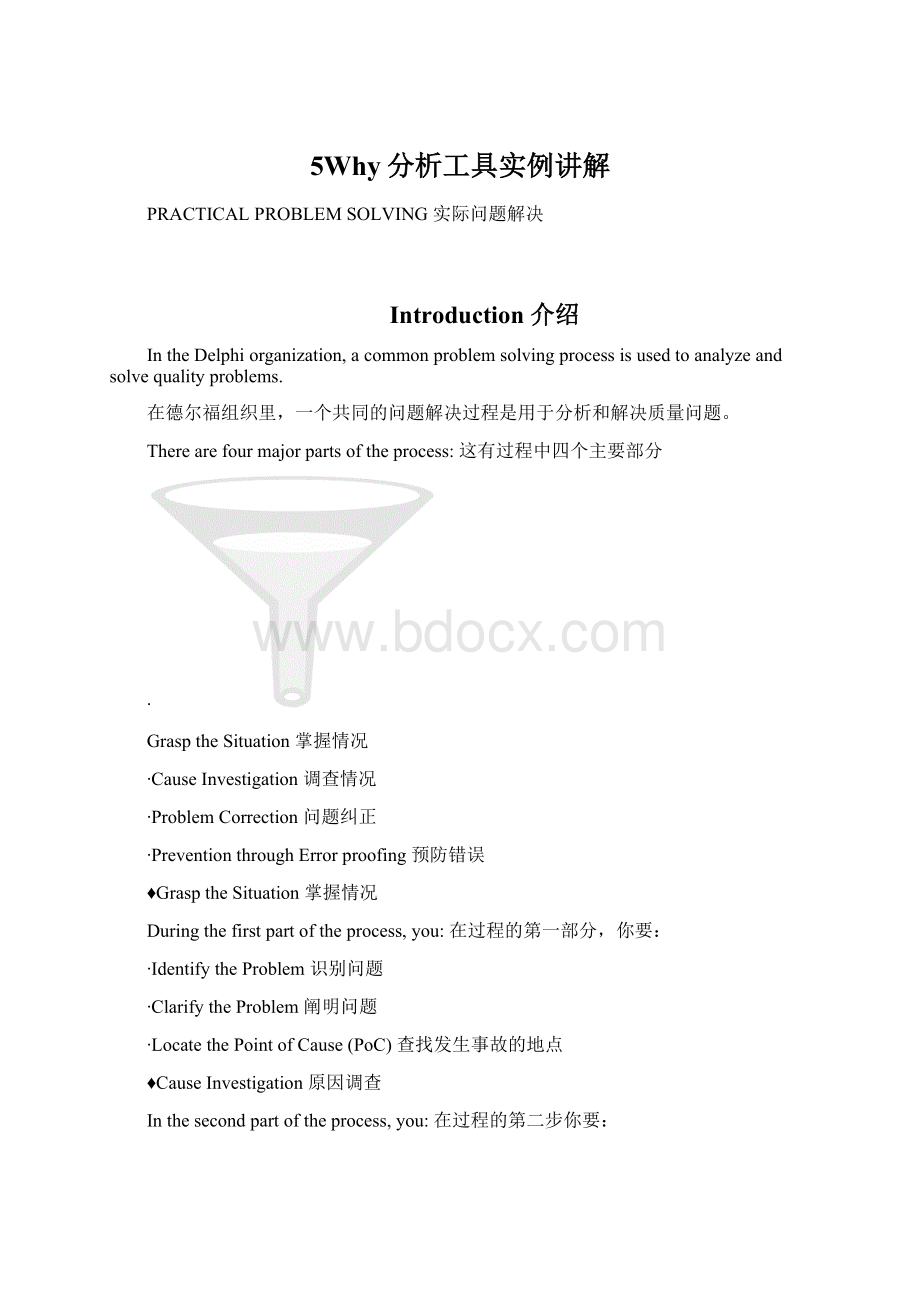5Why分析工具实例讲解.docx
《5Why分析工具实例讲解.docx》由会员分享,可在线阅读,更多相关《5Why分析工具实例讲解.docx(18页珍藏版)》请在冰豆网上搜索。

5Why分析工具实例讲解
PRACTICALPROBLEMSOLVING实际问题解决
Introduction介绍
IntheDelphiorganization,acommonproblemsolvingprocessisusedtoanalyzeandsolvequalityproblems.
在德尔福组织里,一个共同的问题解决过程是用于分析和解决质量问题。
Therearefourmajorpartsoftheprocess:
这有过程中四个主要部分
∙
GrasptheSituation掌握情况
∙CauseInvestigation调查情况
∙ProblemCorrection问题纠正
∙PreventionthroughErrorproofing预防错误
♦GrasptheSituation掌握情况
Duringthefirstpartoftheprocess,you:
在过程的第一部分,你要:
∙IdentifytheProblem识别问题
∙ClarifytheProblem阐明问题
∙LocatethePointofCause(PoC)查找发生事故的地点
♦CauseInvestigation原因调查
Inthesecondpartoftheprocess,you:
在过程的第二步你要:
∙Conducta“5-Why”investigationtoidentifytherootcause进行“5-WHY”调查以识别问题根源。
▪forthespecificproblem特殊问题
▪forwhytheproblemwasnotdetected为什么问题没有被发现。
▪forwhythe“system”allowedtheproblemtooccur为什么系统允许问题发生
♦ProblemCorrection问题纠正
Inthethirdpartoftheprocess,you:
在过程的第三部分,你要:
∙Takespecificactiontocorrecttheproblem.Ataminimum,short-termtemporarymeasuresarerequiredtoprotectthecustomer.
采取特殊措施改正问题,至少,要求用短期暂时的方法去保护顾客。
♦PreventionThruErrorproofing预防错误
Inthefourthpartoftheprocess,you:
在过程的第四部分,你要:
∙Takespecificactiontomakesuretheproblemcannotrecur,typicallythrougherrorproofing
∙CaptureLessonsLearned
采取特殊措施以保证问题不在发生,代表性的错误论据
取得课程学习。
PRACTICALPROBLEMSOLVINGMODEL
实际问题解决模型
5WhyFunnel5个为什么漏斗
BASICSTEPSOF
PRACTICALPROBLEMSOLVING
时间问题解决的基本步骤
PartI–GrasptheSituation
第一部分---掌握情况。
♦Step1:
IdentifytheProblem第一步:
识别问题
Inthefirststepoftheprocess,youbecomeawareofaproblemthatmaybelarge,vague,orcomplicated.Youhavesomeinformation,butdonothavedetailedfacts.Ask:
在过程的第一步,你可以意识到问题可能是大的、含糊的或是复杂的,你有一些信息,但是没有详细事实。
问:
▪WhatdoIknow?
我了解什么?
♦Step2:
ClarifytheProblem第二步:
阐明问题。
Thenextstepintheprocessistoclarifytheproblem.Togainamoreclearunderstanding,ask:
过程的下一步是阐明问题,为了得到一个更清楚的认识,问:
▪Whatisactuallyhappening?
实际发生了什么?
▪Whatshouldbehappening?
什么应发生?
♦Step3:
BreakDowntheProblem第三步:
分解问题
Atthispoint,breaktheproblemdownintosmaller,individualelements,ifnecessary.
在这一点,如有必要,把问题分解成更小的单个元素。
▪WhatelsedoIknowabouttheproblem?
我还要对问题了解什么?
▪Arethereothersub-problems?
那里还有其它问题吗?
♦Step4:
LocatethePointofCause(PoC)第四步;查找事故发生的地点。
Now,thefocusisonlocatingtheactualpointofcauseoftheproblem.Youneedtotrackbacktoseethepointofcausefirst-hand.Ask:
现在,中心是查找问题的根源的实际地点,你需要追踪直接的事故点。
问:
▪WheredoIneedtogo?
我们需要去哪里?
▪WhatdoIneedtosee?
我们需要了解什么?
▪Whomighthaveinformationabouttheproblem?
谁可能会有有关此问题的信息?
♦Step5:
GrasptheTendencyoftheProblem第五步;掌握问题倾向
Tograspthetendencyoftheproblem,ask:
为了掌握问题倾向,问:
▪Who?
谁?
▪Which?
那一个?
▪When?
什么时候?
▪Howoften?
(单位时间发生的频率)多少?
▪Howmuch?
多少?
Itisimportanttoaskthesequestionsbeforeasking“Why?
”
在问“WHY”之前问这些问题是很重要的。
PartII:
CauseInvestigation第Ц部分:
原因调查。
♦Step6:
Identifyandconfirmthedirectcauseoftheabnormaloccurrence.
第六步:
识别和确认反常事件的直接原因。
Ifthecauseisvisible,verifyit.Ifthecauseisnotvisible,considerpotentialcausesandcheckthemostlikelycauses.Confirmthedirectcausebasedonfact.Ask:
如果原因明显,验证它。
如果原因不明显,考虑潜在的原因和检查类似事故,以事实为基础确认直接原因。
问:
▪Whyistheproblemoccurring?
问题为什么发生?
▪CanIseethedirectcauseoftheproblem?
我能看到问题的直接原因吗?
▪Ifnot,whatdoIsuspectaspotentialcauses?
如果不能,我猜想潜在原因是什么?
▪HowcanIcheckthemostlikelypotentialcauses?
我怎么检查类似的潜在的原因?
▪HowcanIconfirmthedirectcause?
我怎么确认直接原因?
♦Step7:
Use5-Whyinvestigationtobuildachainofcause/effectrelationshipsthatleadtotherootcause.Ask:
第七步:
利用5Why调查以建立一通向问题根源的原因/结果的关系链。
问:
▪Willaddressingthedirectcausepreventrecurrence?
查明直接原因预防再发生了吗?
▪Ifnot,canIseethenextlevelofcause?
如果没有,我能看到下次再发生的机率吗?
▪Ifnot,whatdoIsuspectasthenextlevelofcause?
如果没有,对于下次再发生的机率我觉察到什么?
▪HowcanIcheckandconfirmthenextlevelofcause?
我怎样检查和确认下次再发生的机率?
▪Willaddressingthislevelofcausepreventrecurrence?
查明事故级别预防再发生了吗?
Ifnot,continueasking“Why?
”untilyoufindtherootcause.如果没有,继续问为什么直到你找到了问题根源。
Stopatthecausethatmustbeaddressedtopreventrecurrence.Ask:
停止这些,预防事故再发生。
问:
▪HaveIfoundtherootcauseoftheproblem?
我找到问题的原因根源了吗?
▪CanIpreventrecurrencebyaddressingthiscause?
我根据找到的原因,预防再发生吗?
▪Isthiscauselinkedtotheproblembyachainofcause/effectrelationshipsthatarebasedonfact?
根据基于事实的原因/结果关系链,这个原因与问题有联系吗?
▪Doesthechainpassthe“therefore”test?
这个链能通过“因此”测试吗?
▪IfIask“Why?
”again,willIbeintoanotherproblem?
如果我再次问“为什么”,我会深入到另一个问题之中吗?
Besureyouhaveused5-WhyInvestigationtoanswerthesequestions:
确信你会用5-Why调查回答这些问题:
▪Whydidwehavetheproblem?
为什么我们会有这种问题?
▪Whydidtheproblemgettothecustomer?
为什么问题会对顾客有影响?
▪Whydidour“system”allowittooccur?
为什么我们的系统“允许”它发生?
5WHYCAUSEINVESTIGATION
5Why原因调查
Step8:
TakeSpecificActiontoAddresstheProblem
第八步:
采取特殊措施解决问题
Usetemporarymeasurestoeliminatetheabnormaloccurrenceuntiltherootcausecanbeaddressed.Ask:
使用临时方法消除反常事件直到问题根源被找出。
▪Doesitcontaintheproblemuntilapermanentsolutioncanbeimplemented?
Implementcorrectiveactionstoaddresstherootcausetopreventrecurrence.Ask:
在执行一项持久解决方案之前,它可以解决问题吗?
实施纠正措施以标明问题根源防止再发生。
问:
▪Doesitpreventtheproblem?
它能预防问题发生吗?
Follow-upandcheckresults.Ask:
跟踪和检查结果,问:
▪Isthesolutionworking?
此解决方案运行了吗?
▪HowdoIknow?
我怎么知道?
PRACTICALPROBLEMSOLVINGCHECKLIST
实际的问题解决检查表
Tobesureyouhavefollowedtheproblemsolvingmodel,usethischecklistasyoucompletetheproblemsolvingprocess.
确信你遵循了问题解决模型,当你完成问题解决过程时使用这项检查表:
Graspthesituation掌握情况
___Pick-uptheproblem.提取问题
___Clarifytheproblem.阐明问题
___Breakdowntheproblem.分解问题
___LocatethePointofCause(PoC).查找发生事故的地点
___Graspthetendencyoftheproblem.掌握问题倾向
CauseInvestigation原因调查
___Identify/confirmthedirectcause.识别/确认直接原因
___Ask5Why'stoidentifytherootcause.提问5Why去识别问题根源
___Ask5Why'sfor“Whytheproblemwasnotdetectedandreachedthecustomer?
”
提问5Why中的为什么问题没有被顾客发现和传达。
___Ask5Why'sfor“Whydidthesystemallowtheproblemtooccur?
”
提问5Why中为什么系统允许问题发生?
ProblemCorrection问题纠正
___Implementcorrectiveaction;ataminimum,implementtemporarymeasures
实施纠正措施;至少实施临时方法。
Prevention预防
___Errorprooftherootcause.错误论证问题根源
___CaptureLessonsLearned.取得课程学习
ACTIVITY:
活动
FLEXINDUSTRIESCASESTUDY
弯曲工业事例研究
Directions:
说明
▪UsetheDelphiProblemSolvingProcesstoevaluatetheFlexIndustriesCaseStudybelowandonthefollowingpages.Reviewthe5-WhyInvestigationresultsonPage11.
使用德尔福问题解决过程,评价页底及下页的弯曲行业事例研究。
评审第11页的5-Why调查结果。
▪UsetheworksheetsonPages13and14torecordyourwork.使用第13、14页的工作表记录你的工作。
▪Useonlytheinformationprovided.仅用于假设信息
▪Donottrytore-engineertherivetsorsolvethetechnicalproblemsinthecasestudy.ThepurposeofthisactivityistousetheProblemSolvingmodeltoorganizethegivendata.
在这个事例研究中,不要试图模仿设计铆钉或解决技术问题。
这项行动的目的是使用问题解决模型去组织特定数据。
FLEXINDUSTRIESCASESTUDY
弯曲工业事例研究
Background背景
JakeRyanistheQualityManageratFlexIndustries.Flexisacomponentsupplierthatmanufacturesmetalstampingsandlightassemblyproducts.Thecompanyhasareputationforsupplyinghighqualitypartsonaconsistentbasis.Seldomhastherebeenacustomercomplaint.FlexhasQualityrepresentativescalledCustomerSupportEngineers(CSE’s)ateverycustomerassemblyplant.TheCSE’sreportanyproblemstoJakeforinvestigationandfollow-up.
JackeRyan是弯曲行业的质量经理,弯曲是生产金属冲压件和照明装配产品的供应商的组成部分。
此公司在提供高质量产品上享有声誉。
很少有客户抱怨,Flex的每个顾客装配厂都有称为顾客支持工程师(CSE)的质量代表,顾客支持工程师给Jacke报道大量问题,以调查和跟踪。
At7:
00a.m.thismorning,JakereceivedacallfromJanet,CSEattheWindingRiverAssemblyPlant.Janetinformedhimthatthecustomerhadfoundfivedefectivestabilizingbracketsonsecondshiftlastnight.Shecheckedtheremaininginventoryandtherewerenodefectsintheremaining326pieces.Themanufacturingstickeronthebackofthebracketsindicatedthattheyweremadebythesecondshiftoperator.Normally,thestabilizingbracketisfastenedtotheregulatormotorwiththreerivets.Thefivedefectivebracketshadonlytworivetsinthem.Thelowersetofrivetsonallfivebracketswasmissingarivet.Thiswasthefirsttimethattheproblemoccurred.
早上7:
00Jake接到了JanetWandingRiver装配厂的CSE,Janet的电话,告诉他昨天晚上在第二轮班,顾客发现五个有缺陷的固定支架,她检查了剩余的存货且剩余的326个产品没有缺陷。
支架背部的生产标签显示,它们是第二轮班操作工制造的。
通常固定支架用三个铆钉固定在发动机调整器上。
这五个支架上较底位置的铆钉缺少了一个,这个问题是第一次发生。
GOODBAD
Jakeset-upcontainmentproceduresattheplantwarehousetosortfordiscrepantmaterials.Asofthismorning,twomoredefectivebracketshadbeenfoundintheremaining2019piecesofinventoryatFlex.
Jake对仓库施行围堵政策程序,以挑选差异原料。
就在今天早上,在Flex剩余2019个存货中发现了不至两个缺陷支架。
CauseInvestigation原因调查
Jakewentouttothefloortotalkwiththeteamleaderofthetworivetlines(EastandWest)andtheareaqualityassuranceauditor.HeinformedSam(theteamleader)ofthequalityproblemandaskedhimtoidentifythelinewhichrunsthestabilizingbracketassembly.SamdirectedJaketotheEastlinewhichrunsWindingRiverassemblybracketsonly.
Jake去基层与东西两个铆钉生产线的领导组和区域质量保证审核员谈话。
他告诉Sam(本组领导)这个质量问题。
并且要求他验证是哪个线进行固定支架装配的。
Sam直接告诉Jake仅东线进行WindingRiver支架装配。
AttheEastLine,hespokewithJudy(theQAAuditorforthearea)andaskedtoseethequalitylogsheets.JakeandJudyreviewedtheNov.11thlogsheetandcouldnotfindanythingoutoftheordinary.Heaskedhertoset-upin-housecontainmentprocedurestosortforanydiscrepantmaterialinthefinishedgoodsarea.
在东线,他与Judy(此区域QA审核员)讲话并且要求去看质量日志表。
Jake和Judy评审了11月11号的日志表,并没有发现任何异于平常的事情。
他要求她去建立内部围堵政策程序在成品区挑选任何差异原料。
Next,Jaketriedtolocatethesecondshiftoperatorwhoseclocknumberwasonthedefectiveparts.Sincethat